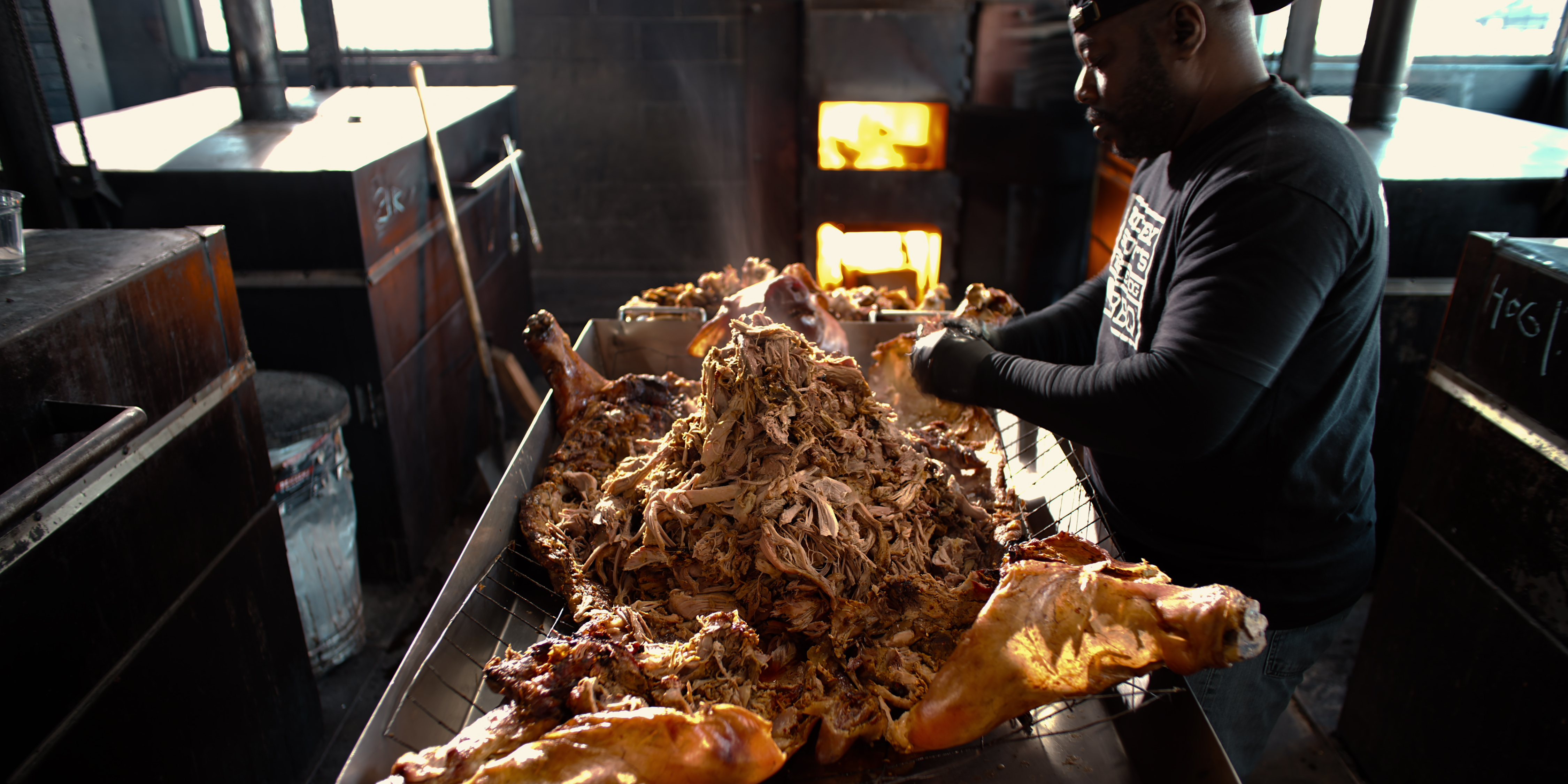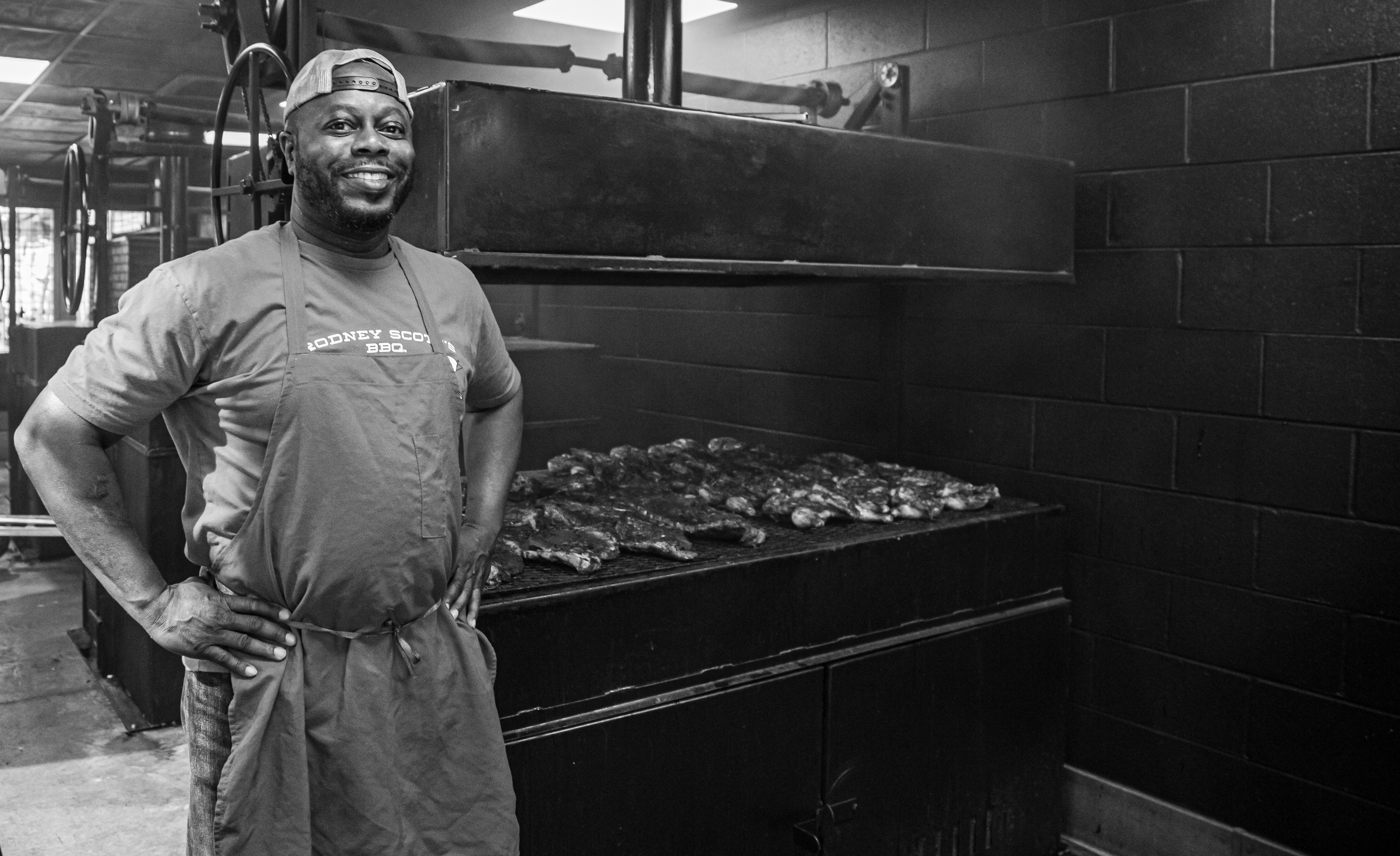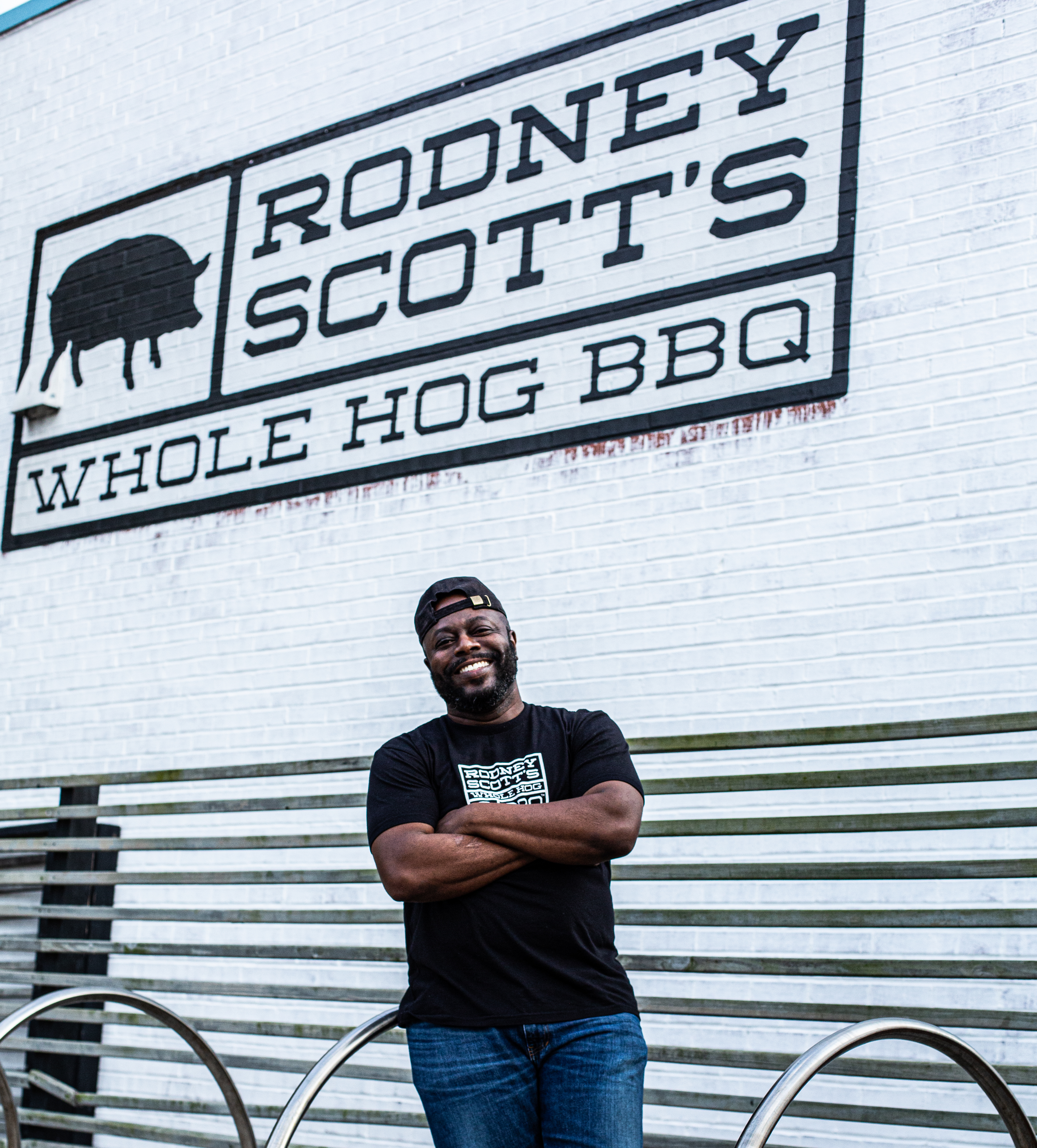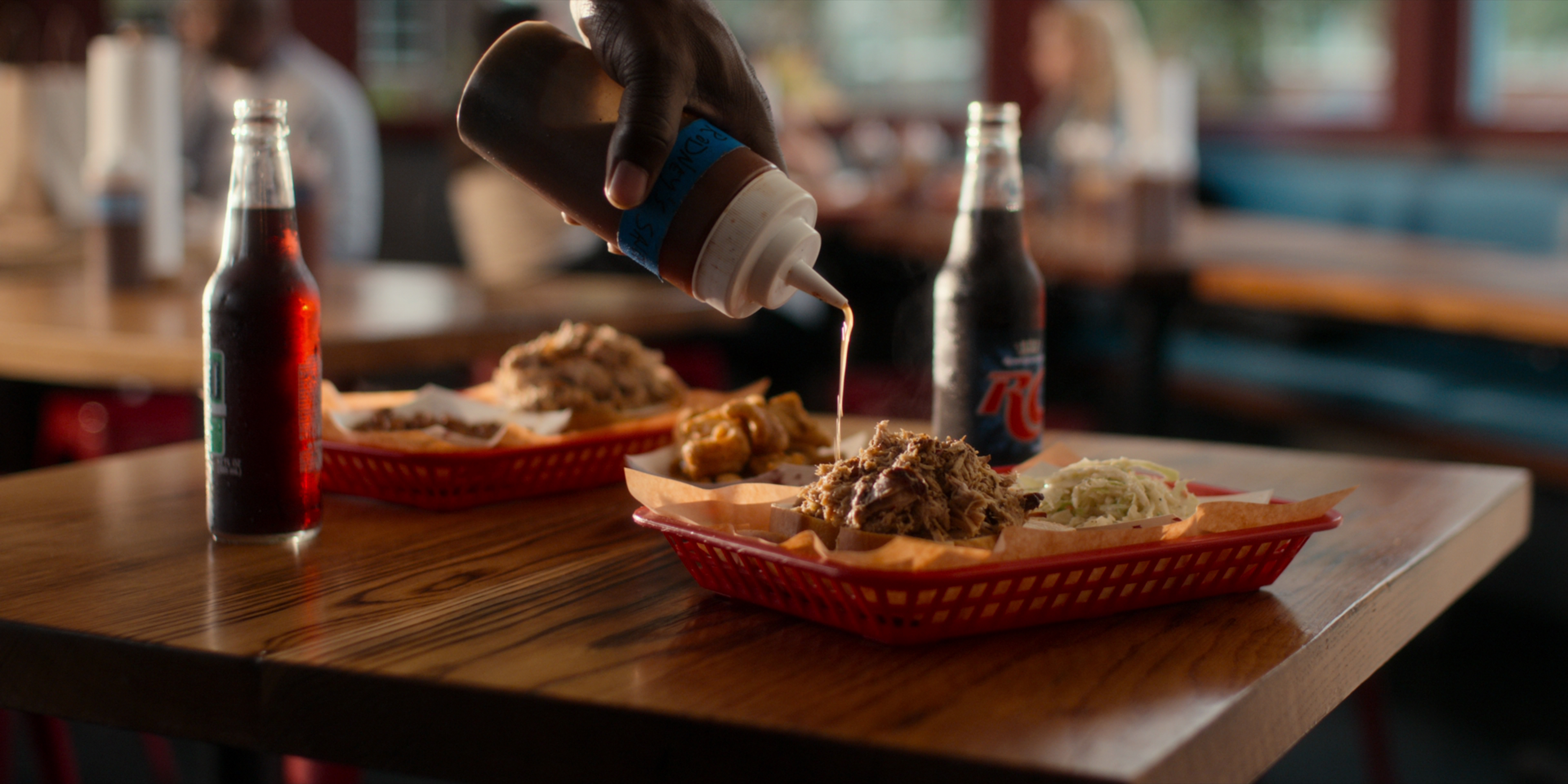
Rodney Scott is the pitmaster we all long to be in our wildest barbecue dreams. The widely-acclaimed chef has spent his entire life nailing down the art of whole hog BBQ in the small hamlet of Hemingway, South Carolina. Over the years, his ability to create a truly transcendent culinary experience with pork, a little spice, and a dialed-in list of sides has made him part of the food world elite — even without the trappings of fine dining.
But when Chef’s Table came knocking it brought the pitmaster a whole new level of renown. Watching Scott’s episode of the recently released Chef’s Table BBQ, it quickly becomes clear that this is a man expressing his life’s purpose through the food he cooks. He works by feel and yet… there’s an undeniable precision to every move he makes. It’s the fine balance between artist and artisan; freethinker and technician.
We caught up with Scott last week to talk about his abiding love for whole hog. The conversation touched on what it’s like getting featured on the acclaimed Netflix show, running a restaurant in the COVID age, and, of course, all things BBQ — sauces, rubs, sides, and best bites. In every answer, you can see the passion and joy of a man lucky enough to have found his true calling.

Let’s talk a little bit about the genesis of you becoming a pitmaster.
My pitmaster skills started way back, as early as a teenager. My very first hog was at eleven-years-old. When I got into my teens — 13, 14-years-old — it was more hands-on, more regular. It was a day-to-day routine, a day-to-day chore. We were a small family business that did whole hogs three days a week. We would cook anywhere from six to ten hogs a week on average.
It was mostly whole hog and chickens. This went on continuously. It was every week. At least three times a week, I was cooking whole hogs. I was learning and cooking the entire time in this tiny town, Hemingway, and that’s where I got recognized for barbecue. Our family business got recognized for barbecue, and I would always be the one person that they would hold conversations with about what we’re doing and how we’re doing it. Eventually, it led to some press and eventually led to doing different events, going mobile, and people liking our styles and the way that we did our barbecue. Here we are.
One of my favorite scenes in the new season of Chef’s Table is you out in the woods chainsawing wood and chopping wood. How important is the right wood?
Man, the wood that we use for barbecue is very important. For example, you can’t use certain woods, like pine. You don’t ever want to use that. Hardwoods are very important. You always want to get oak and hickory, pecan or pea-can, depending on wherever you’re from. You always want to use a hardwood to make sure you got a good flavor on it.
For me personally, I like the hickory and the oak. That’s important to me.
Your spot in Charleston — Rodney Scott BBQ — has a special smoker where the top comes up and down on a pulley. Did you design that yourself or was that something you found?
The pits that we have in Charleston currently, I did not develop alone. I had some input on it. Me, the architect, Rich Gibson, and the welders, we all got together and we had this question of, “where do you put the lids when it’s time to flip the hogs?”
The idea of the counterweights came in and they go up and the exhaust on the pits and telescope through the roof to let the smoke out of the room. That was just us brainstorming at a table with some architects and welders, and there came these pits.
What is the classic South Carolina spice mix to use on a whole hog?
Oh, man. Cayenne and black pepper are the main two things that I’m always tending to find in a lot of Carolina mixes. I do have a hog seasoning with the cayenne, the black pepper, some crushed peppers in there, and some salt. Pretty much your basic everyday seasoning for the hog.
Right — keeping it simple and letting the hog shine.
Yep, less is more.

How did your episode of Chef’s Table come about? Was it the sort of thing where you got a call one day and you’re like, “Nah, this can’t be real”…?
That’s exactly how it came to be. We were cooking out in San Francisco and we had a conversation with these guys — and I had no clue who they were — and I’d already been out there cooking all night and serving all day, and it escaped my memory and I didn’t really remember it. Before you knew it, I had a call saying, “Chef Table’s wanting to come over.” And I’m like, “Yeah, right.”
I thought to myself, “That’s huge. That’s Netflix. They don’t want to talk to me!” But apparently, word of mouth got out. The producers got in touch with us and we discussed the time and the date. Then we filmed.
Was there a bit of nostalgia talking through your life story out in Hemingway?
I’m used to it because I’m always out in Hemingway. But the nostalgic feel … You know, just the opportunity to be able to tell the story of barbecue — which is such a huge part of the South and very mainstream down here — to the world and to be recognized on the same level as white-tablecloth restaurants is amazing. It was amazing just to get that point across and tell our version of that story from this tiny town, Hemingway, through Charleston and to the entire world. It was super exciting.
This is a year that is obviously very different for everyone. It seems like you were already set up for carryout with a drive-through and so on. How have you had to adapt otherwise?
We adapted very carefully, very slowly. The first thing was safety. We wanted to make sure all of our staff was in the best shape that we can keep them in: Checking temperatures, washing hands, constantly on the phone with the family at PRG — our restaurant group — discussing safety measures, CDC rules, and regulations, and making sure that all of our staff was kept up and well-fed. This is a struggling time and a lot of them had kids at home. Having the drive-through was a big help that helped us to adapt to make sure that we’re just dealing with the drive-through and no hands-on in the beginning.
And as we move forward, we continue to follow CDC rules, constant cleaning, constant wiping down, temperature checks, checking on employees, and people see that. Our consumers see that we’re doing the best that we can, and that’s all we could do. And that’s for everybody. All we can do is the best that we can. So we adapted pretty well by staying on top of things and staying in communications and conversations every day with everybody to make sure that we can adjust through this pandemic safely.
That’s great to hear, man. Let’s talk about the food a little bit more. The pork is obviously the star of the show, but for you, what are the side dishes you can’t go without?
Side dishes? Man, mac, and cheese, can’t do without it. French fries always catch my eye. Baked beans. Wow. Every now and again, I grab a couple of hush puppies and the pork skins, man. Pork skins in the bag — that we have, yes.
Anything that doesn’t “catch your eye?”
I’m a little hesitant on the collard greens.

I also noticed you were making a banana pudding there at the end of the episode. What do you feel is the key to a good banana pudding?
Lots of cookies. As a kid, my mom made banana pudding on Sundays and I would get all the broken vanilla wafers at the end of the box. Now, when we make the banana pudding, I make sure we have lots of vanilla wafers in there because that’s my thing, man. I love me some vanilla wafers.
When you’re pulling apart a hog, what’s the one morsel that you want for yourself?
That one morsel I love to have for myself is right under the rib, just before the belly starts I like to go right in there, right in between. That’s my favorite little grab.
Are you ready for the “Chef’s Table Effect?” Are you bracing yourself for the onslaught that’s going to come after things open up and the episode gets seen more?
I’ve been trying to brace myself. We’re very excited, nervous. I’m getting a little bit more sleep on certain nights, but I’m super excited just to tell our story, to get it out there and let the world see what we do.
I think I’m ready.
I want to dive into your expertise a little bit more. You’ve been doing whole hogs pretty much your whole life and, now, all over the country. What do you think the one thing people misunderstand the most about what you do?
The physical timing. It’s very physical. You’re moving an entire animal around. That’s work that’s heavy.
And the timing, a lot of people lose patience with how long it takes. The one thing you do have to have is patience when you’re cooking a whole hog because you’re going to go a minimum of anywhere from eight to 12 hours depending on the size of the animal. Usually, folks tend to lose patience with the timing and the physical labor of it, getting the wood ready, burning it down, putting that entire animal on the pit. Then you got to just stay there for the rest of this cook time because it’s all manual.
When it comes to saucing your pork, whether it’s on a bun or on a plate, do you go sweet, spicy, tangy? All of the above?
If I’m in our restaurant, I will go definitely with a little bit of a tangy and spicy. If I’m somewhere else and I feel a little wild, like living on the edge, I’ll add a little sweet to it. I love them both.
You can check out Rodney Scott’s ‘Chef’s Table’ episode on Netflix right now.

